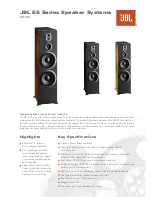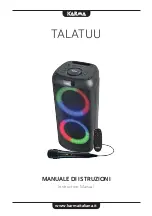
EN
| 34
Bosch Security Systems | 02 April 2004
LTC 8850 |
Instruction Manual
|
Allegiant Server
Calling up a local camera on a monitor will simply
display the video from its physical BNC input. If a
camera is local, Bay and Monitor columns are blank
and cannot be edited.
Remote with Local Overlay/Remote with Remote
Overlay
- A remote camera is NOT directly
connected to the main (Master) bay; it is connected to
a remote (Satellite) bay when the systems are operating
in a satellite configuration. In the Camera Table,
cameras that do not possess an actual BNC on the
Master system (see table) MUST be designated as
remote cameras. Other cameras may be local or
remote (or a trunk). When a remote Satellite camera is
called up on a monitor of the Master system, the
Master obtains the video from the appropriate Satellite
(via a
trunk
input described as follows). The Bay
number (or site address number) in the Camera Table
is used to designate which Satellite the remote camera
is connected to; enter a number from 1 to the
maximum bay number in this column (a Satellite Bay
number is determined by its LTC 8780 Series data
converter accessory unit). The Satellite Master uses the
logical Camera number for a remote camera when
requesting video from a Satellite; the Satellite system
will look up the Camera number in its own Camera
Table to determine which video is required.
The type of overlay affects the text that is displayed on
a monitor’s on-screen overlay. If the Installation is
Remote with Local Overlay
, the Master system will
generate the overlay (just as for a local camera).
If the installation is
Remote with Remote Overlay
,
the overlay generated by the Satellite system is used
instead. This means that the displayed Camera title
will be taken from the Camera Table of the Satellite
system. The system time/date and status portions of
the overlay will also be generated by the Satellite
system, so they might not match those of the Master
system. If desired, a Time Event
Synchronize
Satellites
function can be programmed (reference the
Time Event table functions) in the Master system to
synchronize the time/date of all Satellites. The Monitor
column for a remote camera is always blank.
Trunk
- When a camera is designated as a trunk, it
means that its BNC connector is NOT actually
connected to a camera. Instead, it is used to receive
video from a Satellite. Since a trunk does not
correspond to a specific camera, its Camera Number
and Camera Title fields are blank. The BNC input for
a trunk connects to a monitor output on a Satellite bay.
When the Master system requires remote video from a
Satellite, it directs the Satellite to automatically display
the desired camera on the appropriate monitor. The
Master then receives the video through the connected
trunk input. Several trunks may be connected to the
same Satellite (using different monitors outputs). The
number of trunks connected to a given Satellite
determines how many different videos from that
system can be displayed simultaneously. For example,
if two trunks are connected to Satellite bay number 1,
then up to two different remote cameras from Satellite
bay number 1 may be simultaneously displayed on the
master’s system monitors. A remote camera may be
displayed on any number of the Master’s monitors;
this will use only a single trunk. When a remote
camera is called up on the Master system, the Master
will automatically select an available trunk for
receiving the video. When that video is no longer
needed by the Master, the trunk is free to receive
video from other remote cameras. The maximum
number of trunk lines is as follows:
System
Model
LTC
8100
LTC
8200
LTC
8300
LTC
8500
LTC
8600
LTC
8800
LTC
8900
Mandatory
Remote
Camera #s
9+
17+
33+
65+ 129+ 257+ 4097
+
System
Model
LTC
8100
LTC
8200
LTC
8300
LTC
8500
LTC
8600
LTC
8800
LTC
8900
Max # of
Trunk Lines
8
16
32
64
128
256 4096
















































